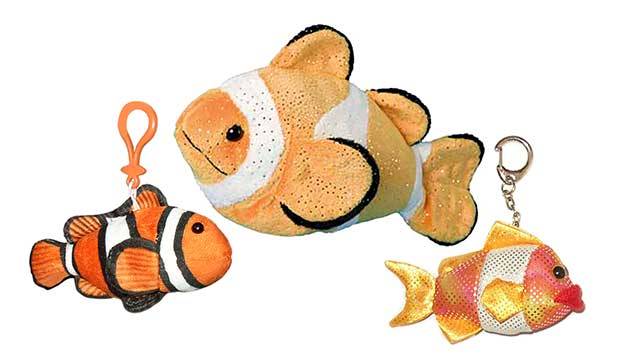

Find Clownfish plush toys in the Ocean at Animals N More.
Find Clownfish stuffed animals, facts and information here at Animals N More. The clownfish stuffed animals shown here include Bobo the Clownfish made by Douglas Cuddle Toys, a Wildlife Artists Clownfish Key Clip and a little clownfish keychain.
The Clownfish,
Amphiprion percula, lives in a symbiotic relationship with giant sea anemones. These creatures of the genera Stoichactis and Discosoma may have a diameter of 16 to 24 inches, and are attached to the bottom by a fleshy base. At the center is the mouth and surrounding this along the edges are hundreds of tentacles, armed with thousands of stinging cells. Heaven help any small fish coming too close to these deadly arms, for it is stung to death and then carried to the anemone's mouth to be eaten.
Clownfish, however, live within the area surrounded by these tentacles exempt from any harm. Although other fishes and small animals are killed by the anemones, when a clownfish darts among these sting-bearing tentacles, they curl away and do it no harm. Even when clownfish brush up against the tentacles, they are not stung. Whenever clownfish are alarmed, they flee to the protection of their anemone. A layer of mucus on the clownfish's skin makes it immune to the anemone's sting.
The anemones also profit by this association. The anemone helps the fish by giving it protection from predators, which include brittle stars, wrasses, and other damselfish, and the Clownfish helps the anemone by feeding it, increasing oxygenation, and removing waste material from the host.
Clownfish are widely distributed from India through the East Indies to Queensland, the Philippines and the islands of the Pacific. Clownfish can exist perfectly well without an anemone partner - in captivity at least, where their peculiar pattern of brilliant colors and their engaging ways have made them very popular. They reach a length of 3-1/2 inches, and are bright orange, with three white bands bordered in black running vertically across the back of the head, the middle of the body and the base of the tail. The fins are bordered with white and black.
The nest of the clownfish is usually located very close to an anemone. The spot is well cleaned and the peculiarly shaped eggs are attached to it in a single layer. The brood may consist of from 100 to 1000 eggs, depending on the size of the female. The eggs are cylindrical in shape with rounded ends. Both parents cooperate in caring for their spawn, the male performing the greater part of the actual care of the eggs. For seven to ten days he watches over them, cleaning them with his mouth. Meanwhile, the female, which may be twice as large as her mate, usually remains close by.
The newly hatched larvae travel to the water surface where they float for about two weeks. At first they are about 3/16ths of an inch long and gray in color. Within two weeks they have started to assume the color pattern of the adult, and at this time they drop to the bottom to search for an anemone of their own. Clownfish are quite prolific. In nature, reproduction takes place during most of the year.
Clownfish are protandrous hermaphrodites, which means that all fish develop into males first and then potentially into females later. More than one Clownfish may reside in the same anemone. If the female were to die, the largest male would then become female. The change is irreversible. The large female is dominant and using aggressive dominance is able to control the formation of other females. Clownfish are in social groups comprised of a breeding pair and 0-4 non-breeding male fish.
Clownfish are non-migratory. In the wild, they live 6 to 10 years, while in captivity they are recorded as living as long as 18 years. Predators include large fish, sharks and eels.



